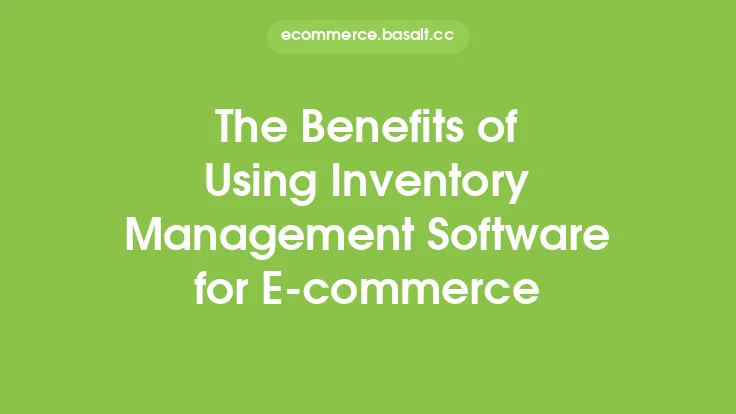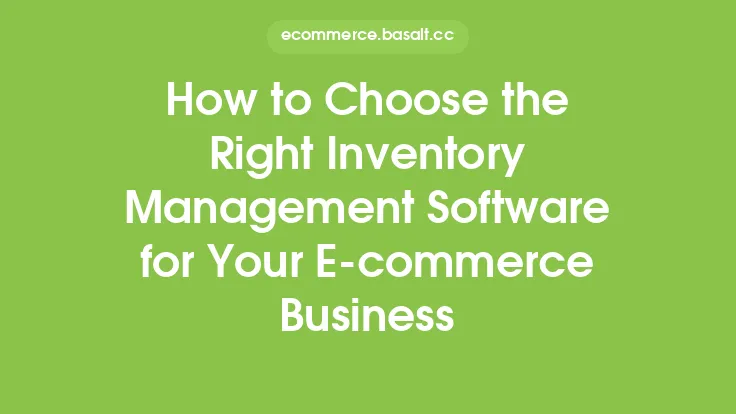Effective e-commerce inventory management is crucial for the success of any online business. It involves the coordination of various processes, including inventory tracking, order fulfillment, and supply chain management. The goal of e-commerce inventory management is to ensure that the right products are available at the right time, in the right quantities, and at the right cost. In this article, we will discuss the best practices for maximizing efficiency in e-commerce inventory management.
Understanding E-commerce Inventory Management
E-commerce inventory management involves the management of inventory across multiple channels, including online marketplaces, social media, and the company's own website. It requires the ability to track inventory levels, monitor product movement, and analyze sales data to make informed decisions. Effective e-commerce inventory management also involves the management of inventory storage, shipping, and handling, as well as the coordination of supply chain logistics.
Setting Up an E-commerce Inventory Management System
To maximize efficiency in e-commerce inventory management, it is essential to set up a robust inventory management system. This system should be able to track inventory levels, monitor product movement, and provide real-time updates on inventory availability. The system should also be able to integrate with other e-commerce systems, such as order management and shipping software. When setting up an e-commerce inventory management system, it is essential to consider the following factors: scalability, flexibility, and ease of use.
Implementing Inventory Tracking and Management
Inventory tracking and management are critical components of e-commerce inventory management. This involves the use of inventory management software to track inventory levels, monitor product movement, and analyze sales data. The software should be able to provide real-time updates on inventory availability, as well as alerts and notifications when inventory levels are low. Effective inventory tracking and management also involve the use of barcodes, RFID tags, and other tracking technologies to monitor product movement and prevent inventory discrepancies.
Managing Inventory Across Multiple Channels
E-commerce businesses often sell their products across multiple channels, including online marketplaces, social media, and the company's own website. To maximize efficiency in e-commerce inventory management, it is essential to manage inventory across all these channels. This involves the use of inventory management software that can integrate with multiple channels, as well as the ability to track inventory levels and monitor product movement across all channels. Effective inventory management across multiple channels also involves the use of channel-specific inventory management strategies, such as drop shipping and fulfillment by Amazon.
Analyzing Sales Data and Forecasting Demand
Analyzing sales data and forecasting demand are critical components of e-commerce inventory management. This involves the use of sales data and analytics software to analyze sales trends, monitor product movement, and forecast demand. The software should be able to provide real-time updates on sales data, as well as alerts and notifications when sales trends change. Effective sales data analysis and demand forecasting also involve the use of historical sales data, seasonal trends, and market research to make informed decisions about inventory management.
Optimizing Inventory Storage and Shipping
Inventory storage and shipping are critical components of e-commerce inventory management. To maximize efficiency in e-commerce inventory management, it is essential to optimize inventory storage and shipping. This involves the use of inventory management software to track inventory levels, monitor product movement, and analyze shipping data. The software should be able to provide real-time updates on inventory availability, as well as alerts and notifications when inventory levels are low. Effective inventory storage and shipping also involve the use of storage and shipping strategies, such as just-in-time inventory management and zone skipping.
Implementing Supply Chain Management
Supply chain management is a critical component of e-commerce inventory management. This involves the coordination of supply chain logistics, including sourcing, production, and shipping. To maximize efficiency in e-commerce inventory management, it is essential to implement effective supply chain management strategies. This involves the use of supply chain management software to track inventory levels, monitor product movement, and analyze shipping data. The software should be able to provide real-time updates on inventory availability, as well as alerts and notifications when inventory levels are low. Effective supply chain management also involves the use of supply chain management strategies, such as vendor-managed inventory and drop shipping.
Measuring and Evaluating E-commerce Inventory Management Performance
To maximize efficiency in e-commerce inventory management, it is essential to measure and evaluate performance. This involves the use of key performance indicators (KPIs) to track inventory management metrics, such as inventory turnover, fill rates, and order fulfillment rates. The KPIs should be able to provide real-time updates on inventory management performance, as well as alerts and notifications when performance metrics change. Effective measurement and evaluation of e-commerce inventory management performance also involve the use of analytics software to analyze sales data, monitor product movement, and forecast demand.
Conclusion
Effective e-commerce inventory management is crucial for the success of any online business. It involves the coordination of various processes, including inventory tracking, order fulfillment, and supply chain management. By following the best practices outlined in this article, e-commerce businesses can maximize efficiency in inventory management, reduce costs, and improve profitability. Remember, e-commerce inventory management is an ongoing process that requires continuous monitoring, analysis, and improvement. By staying focused on the ever-changing needs of the business and the market, e-commerce businesses can stay ahead of the competition and achieve long-term success.





